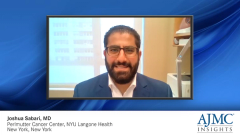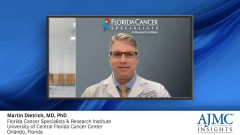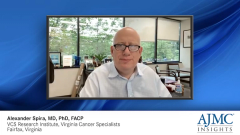
Unmet Needs in NSCLC Treatment
Three medical experts highlight unmet needs they routinely run into while treating patients with NSCLC.
Episodes in this series

Martin Dietrich, MD, PhD: Non-small cell lung cancer has made significant strides toward better outcomes. We've had progress in both the genetic targeting of non-small cell lung cancer, as well as targeting immune therapeutic targets within the tumor microenvironment. The biggest need in non-small cell lung cancer [treatment], in my opinion, is how to treat patients that are progressing on the standard immunotherapy-based agents that are either targeting PD1 or PD-L1. This is an unanswered question. [Another is] optimal sequencing strategies for the generic targeting of non-small cell lung cancer. This is oftentimes not clearly defined; we have some spaces like EGFR, ALK, where we have numerous agents who don't have an exact idea of what the optimal sequencing strategy would be. How to utilize immunotherapies for patients with oncogenic drivers [is another]. There's a lot to learn, still questions to be answered, but overall, the progress has been quite significant.
Alexander Spira, MD, PhD, FACP: The largest unmet need for me in advanced non-small cell lung cancer is patients who are in need of second-line therapy. Outside of targeted mutations—outside of docetaxel, which is what we use right now, and it's not a very good drug—we need second-line treatments to be better than they currently are. The standard of care, docetaxel, has been around for 20 years and has not changed.
Joshua Sabari, MD: The largest unmet need for patients with advanced non-small cell lung cancer who are driver altered—meaning who have a driver mutation—is assessing the post-TKI or post-targeted therapy space, thinking about acquired resistance mutations. For a patient with an EGFR mutation who is treated with frontline osimertinib, the standard of care, who then goes on to have progressive disease, we don't have great approved therapeutics that are targetable or targeted with the currently identified resistance mutations. For things like C797S or MET amplification, we need to do more to identify our therapeutics and multiple therapeutics in development. For the driver mutant population, [we have to] think about the resistance setting, as well as intracranial response and very high rates of CNS metastasis in the driver mutant population. Unfortunately, in the EGFR and ALK space, our therapeutics have good CNS activity, but in other spaces, such as BRAF or potentially KRAS G12C, therapies to date have not proven to have good CNS activity. In the non-driver population, those who are offering a PD-1 or PD-L1 inhibitor and really thinking about second line in the PD-1, PD-L1 resistant or refractory [setting], these are patients who have single agent chemotherapies available or combination chemotherapies with response rates that are in the 15%–20% range. Across the board, second-line non-small cell lung cancer is a huge unmet need, as well as brain metastasis for our patients with advanced staged disease.
This transcript has been edited for clarity.
Newsletter
Stay ahead of policy, cost, and value—subscribe to AJMC for expert insights at the intersection of clinical care and health economics.










































